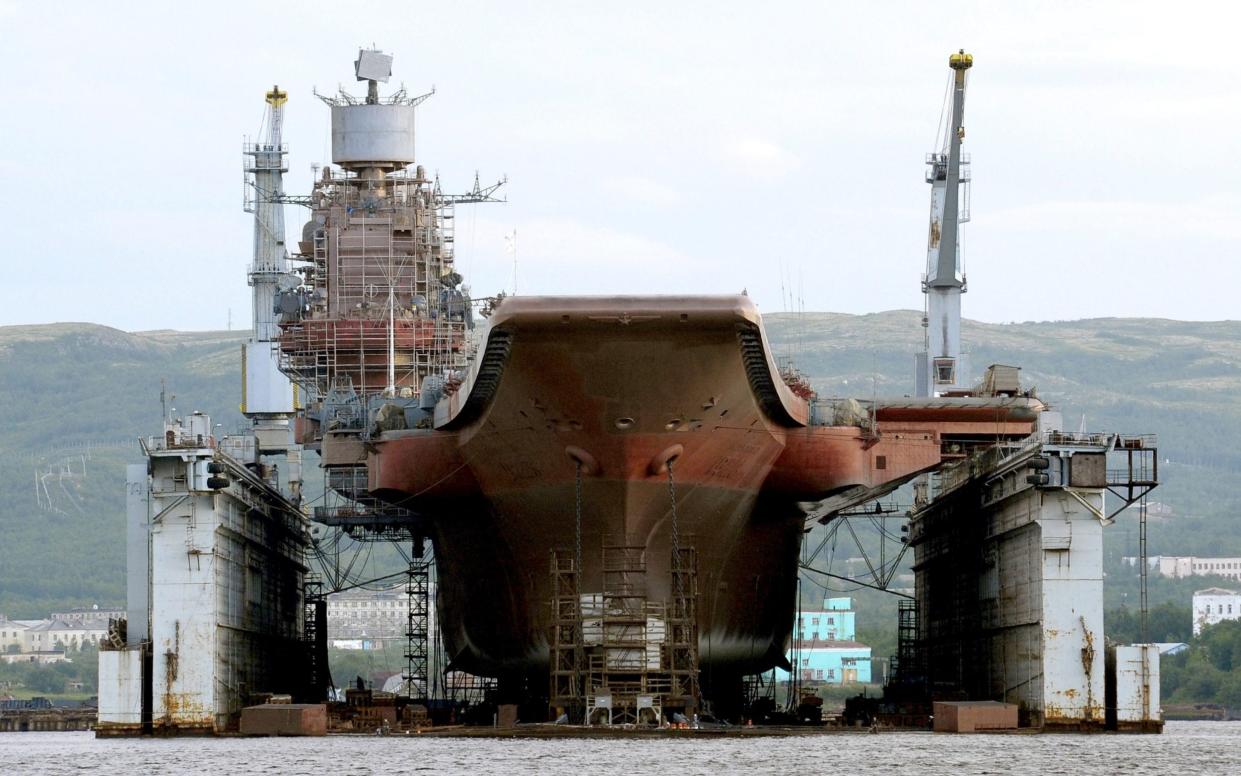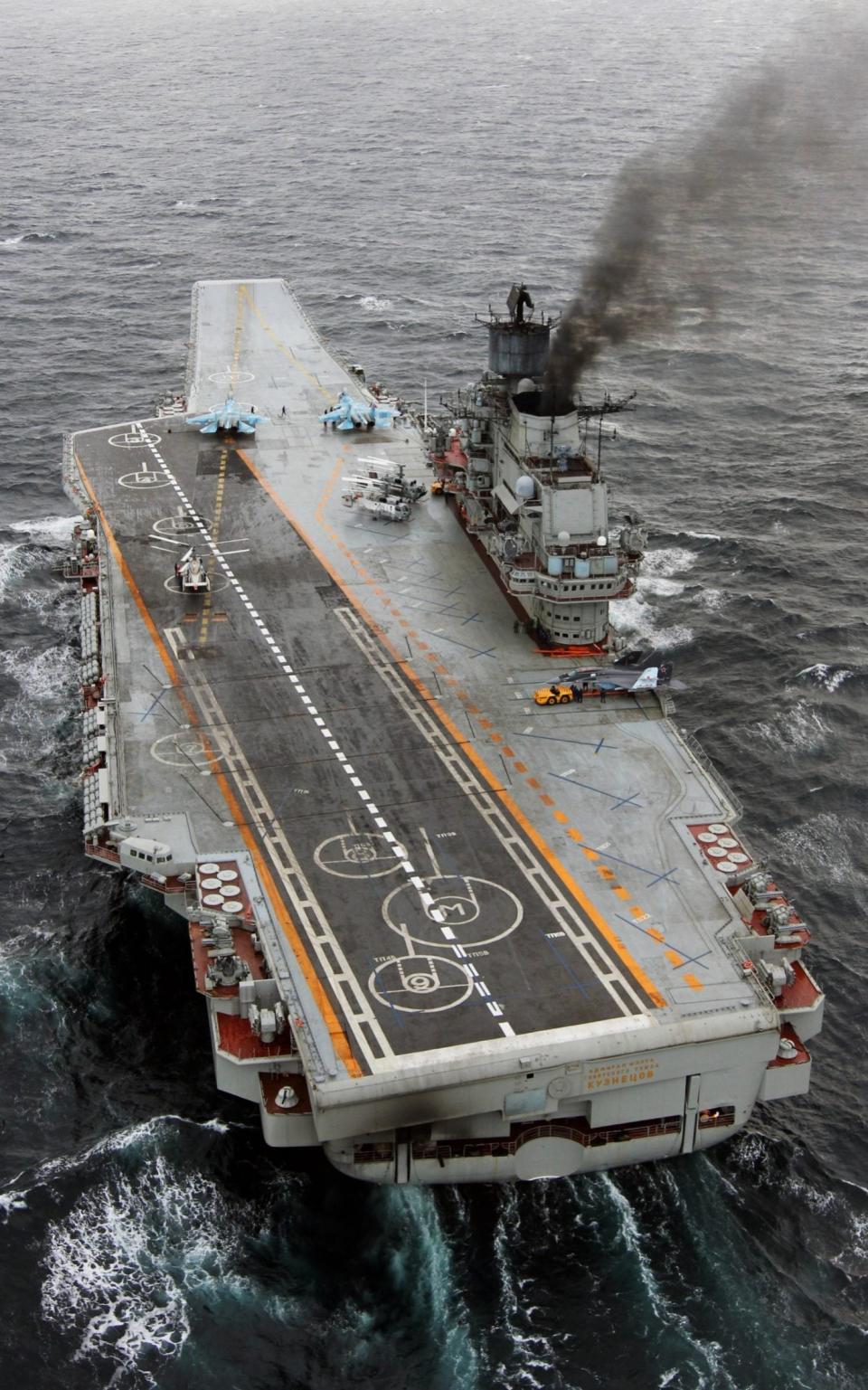Russia is no longer an aircraft carrier nation

The Russian navy’s sole aircraft carrier, the unfortunate Admiral Kuznetsov, was supposed to leave the port of Murmansk, in northern Russia, this spring for the first time in seven years. This according to a July 2023 report in Russian state media.
Kuznetsov didn’t leave. Instead, the 58,000-ton flattop – launched in 1985 and commissioned into the Soviet fleet six years later – remains pierside in Murmansk. Recent satellite imagery shows construction equipment still strewn across her 1,001-foot deck.
The Russian carrier doesn’t have catapults but she does have arrester wires. She operates specially built jet fighters with tailhooks and strengthened airframes to cope with arrested landings, and folding wings for shipboard use. These Russian carrier jets don’t have vertical thrust equipment: they take off from a “ski-jump” ramp under their own power, meaning that they can’t carry as much fuel and weaponry as runway or catapult planes can. Russia’s carrier planes are, however, equipped for air-to-air refuelling, meaning that they can take on more fuel once in the air.
Russia has two types of carrier fighter: the Sukhoi Su-33s that Kuznetsov was originally equipped with and newer Mikoyan-Gurevich Mig-29KRs. It appears that only 24 of each type were acquired by the Russian Navy. The old Sukhois were expected to reach the end of their lives around 2015, but reportedly at least some of them have been refurbished and modernised, and are still flyable.
That Kuznetsov missed her projected start date for post-overhaul sea trials is an ominous sign for the Russian navy’s dwindling aviation capability. For years, experts have speculated that Kuznetsov would never deploy again. That’s looking increasingly likely as the vessel lingers in port.
Kuznetsov has completed just seven patrols since her commissioning 33 years ago. By the standards of other carrier-equipped navies, that’s not a very impressive deployment rate.
During the Russian flattop’s most recent front-line cruise, in 2016 off the coast of war-torn Syria, the ship’s air wing lost two jets to accidents in the span of three weeks: an unsustainable rate of loss for a wing that has just three dozen or so aircraft. The second crash was apparently the result of an arrester wire snapping during a landing: the jet went over the ship’s side and into the sea, but the pilot managed to eject and was saved. There were reports that the Kuznetsov’s jets moved ashore to operate from a land base in Syria while the arrester system was repaired.
The Syria deployment crashes were the first in a long series of recent mishaps that has further stained the reputation of the unreliable carrier. In October 2018, Kuznetsov suffered serious damage in Roslyakovo, a port near Murmansk, when the dry-dock PD-50 sank while the flattop was in it for repairs.
Fourteen months later in December 2019, a fire broke out on Kuznetsov herself during the ongoing repair work. Two workers died. The blaze further damaged the vessel’s already fraying electrical system.
As the smoke cleared and the extent of the damage became clear, fleet leaders considered decommissioning the weary old vessel. Instead, the Kremlin opted to repair Kuznetsov while also replacing the ship’s ancient boilers. The ship’s boilers spew thick black smoke, reportedly because she burns “mazut”, a type of low-quality heavy fuel oil often used in power plants and for heating in former Soviet Union countries. In the West, the crude oil fractions which make up mazut are usually catalytically cracked into diesel and lighter distillates.

The Kuznetsov’s boilers and steam turbines aren’t just smokey: they’re unreliable too. The old ship has frequently been accompanied by a large ocean-going tugboat, to tow her if she breaks down.
Following her latest lengthy spell in dock, it had been planned for Kuznetsov to return to sea for trials in 2022. But then, in December 2022, yet another fire broke out on the ship. Alexei Rakhmanov, head of Russia’s United Shipbuilding Corporation, insisted the fire was “small.” “All the relevant fire systems worked normally,” Rakhmanov said. “There was no damage and no casualties.”
Maybe that was true. Maybe the 2022 fire didn’t add delay to Kuznetsov’s already long-delayed overhaul. But something did. It usually takes American shipyards around three years to overhaul one of the US Navy’s 11 nuclear-powered flattops; so far, it’s taken seven years for a Russian shipyard to overhaul the smaller, less-complex, conventionally-powered Kuznetsov – and there’s no end in sight.
Any other carrier-equipped fleet might just cut its losses, decommission a hopelessly decrepit flattop and build a new one to replace it. But Russian industry probably isn’t capable of building a direct replacement for Kuznetsov.
Russian surface shipyards never really recovered from the Soviet Union’s collapse. Some big old ships such as Kuznetsov remain in service, but new construction focuses almost entirely on smaller, simpler surface ships – frigates, corvettes and coastal patrol vessels – as well as submarines.
“The main issue is engines,” said Pavel Luzin, a military expert at Russia’s Perm University. Factories in Ukraine built most of the Soviet navy’s big maritime engines. It should go without saying the Ukrainians no longer export major defense items – including these engines – to Russia.
And the Russians haven’t managed to establish their own production of similar engines. Western sanctions complicate, if they do not completely prevent, imports of suitable foreign powerplants.
Perhaps the strongest signal that the navy has all but given up on Kuznetsov, or a near-term replacement, is what it’s doing with the carrier’s planes. The fleet has staged some of the carrier’s 22 Mikoyan MiG-29KRs in northern Russia for land-based air-defense patrols.
It seems other naval MiGs deployed to Crimea, in Russian-occupied southern Ukraine, to support the Russian air campaign. In mid-May, a Ukrainian rocket strike on a Crimean airfield blew up at least one Russian MiG-29 – possibly one of the former carrier planes.
That the Russians are willing to risk the unique carrier-capable MiGs in combat in Ukraine underscores how unlikely these same planes are to ever return to sea. Russian carrier aviation is fading away, just as more successful nations – the UK, Japan, Turkey and others – are joining or re-joining the aircraft carrier club.

 Yahoo News
Yahoo News 
